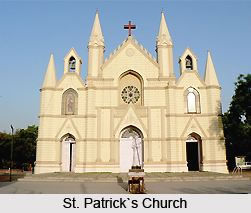 The Camp area in Pune stands widely in contrast with the others, with its crowd of elite, colonial British buildings, still holding back their imperial charm. The families residing here belong to the regal and upper-class quality of families, with other instances of colonial architechture lie educational institutions, clubs, churches, or seminar halls.
The Camp area in Pune stands widely in contrast with the others, with its crowd of elite, colonial British buildings, still holding back their imperial charm. The families residing here belong to the regal and upper-class quality of families, with other instances of colonial architechture lie educational institutions, clubs, churches, or seminar halls.
There existed a time was when people here led an easygoing, semi-urban, civil or military existence, with their social life centring on the racing season, the Poona Gymkhana (now the Poona Club) and the golf course. It has now become a prospering part of the city. Thankfully, several of the magnificent old trees and buildings here still stand.
It is best to begin with Mahatma Gandhi Road, which runs north to south, and one can walk down its length. At this stage, one is in reality at the commercial edge of cosmopolitan Pune, the most wanted jaunt of hip youngsters and global brands. Around this hub is where the British had settled and built their colossal cantonment. A leisurely walk through streets east of and parallel to M.G. Road (once pertinently called Main Street) will carry one back to colonial times. Close to the top of M.G. Road, one must look for the Poona Drug Store and an eatery across the road called Mar-zo-rin - survivors both from the earliest days of Camp commerce. Mar-zo-rin has brilliantly restituted its top floor and is well worth a look-in.
Roads here are wide and tree-lined. The bungalows are well built on generous grounds. The double tiled roofs and the verandah that often runs right around the bungalows are the ones commanding a keen look. After continuing east, one will ultimately come to the racecourse, another institution in British Poona. The Royal Western India Turf Club is one of a handful of institutions still permitting the regal title. Looking east across the racecourse, one will see the elegantly reinstated St. Patrick`s Church. One will momentarily feel that one is in a corner that is forever England. This, after all, was Verrier Elwin`s other pole.
Most of colonial Pune`s institutional buildings are in and around the area. The 19th century Council Hall is built in Italian style. The Records Office across the street is more emblematic of colonial government architecture. Closeby, the General Post Office (1874) is another illustration, while a little distance away, the Engineering College is a low-rise representative of the Indo-Saracenic style. Now-a-days, the compound wall of the Engineering College gallantly proclaims that it is a heritage building.
A traveller visiting Pune should always be informed that the heritage architecture here is humble in every way, a thin shadow of the neo-Gothic wonders of South Mumbai. Even the old Governor`s Residence (now the University of Pune building) in Ganeshkind is an unpretentious structure. The exception is the Deccan College. Situated near Kirkee on the north bank of the Mula-Mutha River, the college is an arresting neo-Gothic creation in stone, with its short towers and refined vaulted hallway.
Several splendidly preserved and reinstated (many even dilapidated) instances of the classic Pune bungalow style of architecture are witnesses everywhere in the Civil Lines and the Cantonment. Though acknowledged for being home to Rajneesh Ashram, Koregaon Park actually captures cosmopolitan Pune through evolution. The neighbourhood is a comprised microcosm of the cream of Anglophile architecture. Several lesser noble families owned and still own stately homes here. There is even a house here that is a reduced model of the White House in Washington. The bakeries must not be missed for which the Camp is especially distinguished.



















